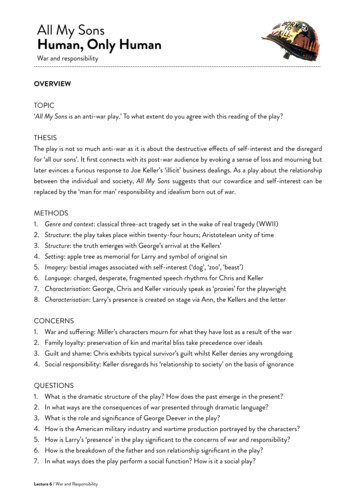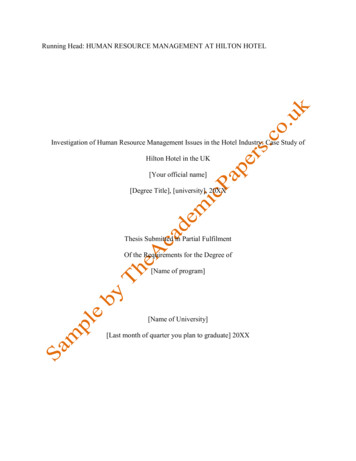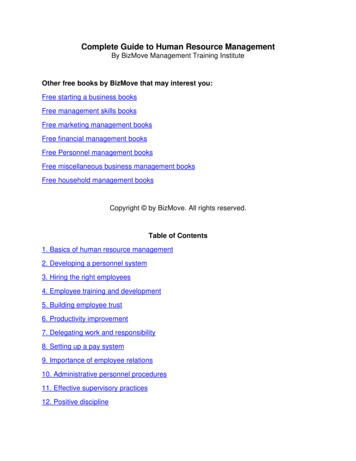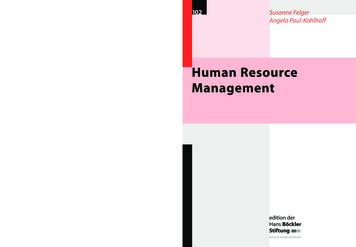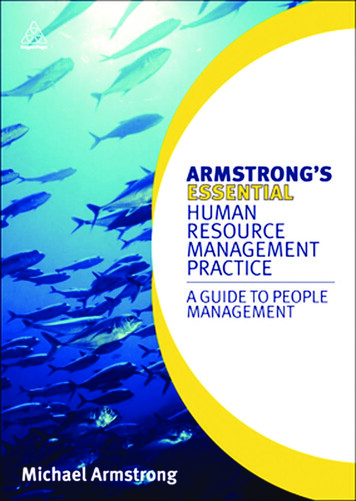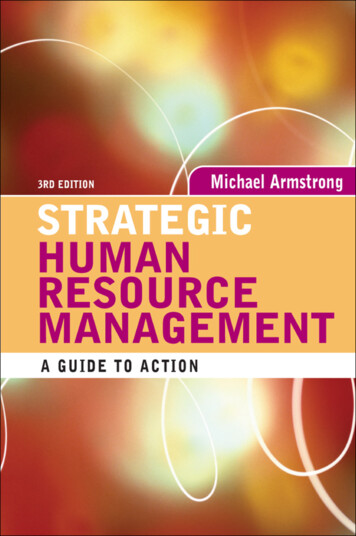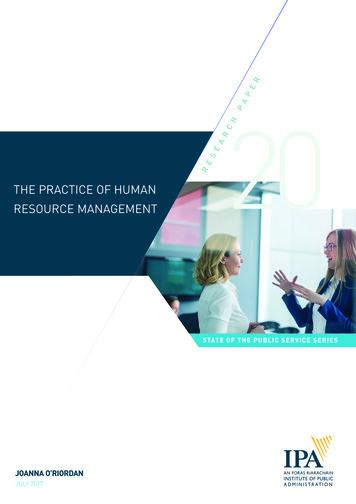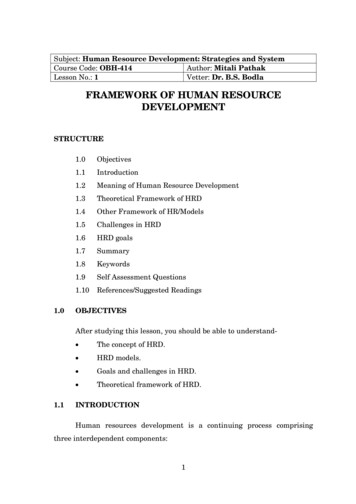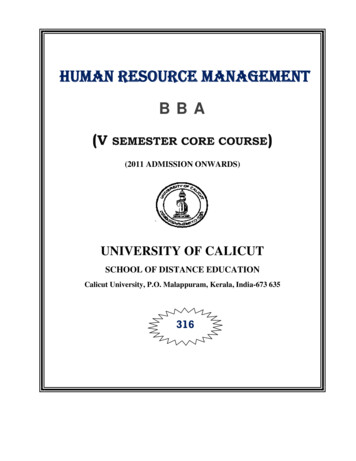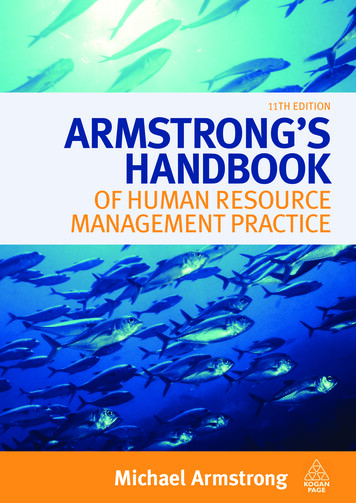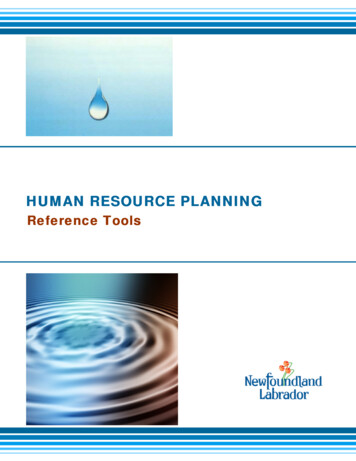
Transcription
HUMAN RESOURCE PLANNINGReference Tools
TABLE OF CONTENTSTAB1Introduction2Human Resource / Workforce Planning and Departmental PlanningoSupplement - A Guide to Integration and AlignmentSTRATEGIES3456Developing a Talent PooloSuccession PlanningoSuccession Planning and Management ariesoInternship ProgramsoApprenticeship ProgramsoLearning and DevelopmentoAssignment OpportunitiesoEntry-Level PositionsWork EnvironmentoLeadershipoCommunicationoHealth and SafetyOrganizational EffectivenessoStructures, Processes, and Position DescriptionsoScope of PracticeoDepartmental CollaborationAdditional ResourcesoDeveloping an Integrated Talent Management ProgramoEntry InterviewsoExit Surveys / InterviewsoAttraction and Recruitment Strategies – Public Service CommissionHUMAN RESOURCE PLANNING – Reference Tools
INTRODUCTIONIn order to position the organization for success, Departments have been engaged inworkforce planning.Corporately, three key directions have been identified to assistgovernment in managing the workforce changes. They include:1. Building Our Potential2. Strengthening Our Competitiveness3. Renewing Our WorkplaceThe purpose of this exercise was to ensure that our workforce and strategic objectives werealigned to guarantee the delivery of quality programs and services to the public, and thatthe planning would assist in positioning the public service for the future. Through acollaborative process, each department developed their own workforce plan, whichoutlined their critical strategic issues for the next 3 – 5 years as well as proposed strategiesto address those issues.Some key examples of how departments can plan for the future workforce are outlined inthis document and could be used to help mitigate any negative impacts as a result ofdemographics, government priorities and competency requirements. They can also helpensure that departments have what they need to get the job done, and that there is efficientmatching of skills and competencies to departmental tasks, requirements and outcomes.To better compete in the global market, government will need to create and implementcorporate strategies to promote itself as a “preferred employer” – investing in progressiveHR policies and programs with the goal of building a high-performing organization ofengaged people, and fostering and creating a work environment where people want towork, not where they have to work.HUMAN RESOURCE PLANNING – Reference Tools
Retention and attraction in today’s changing labour market requires government to look atthe key drivers that are important to employers and potential employees. Examples ofthese include offering employees: Diversified and Challenging Work An Attractive Compensation Package (not just salary) Advancement Opportunities Access to Continuous Learning Opportunities for Personal and Professional Growth An Inclusive Workplace Work-Life Balance Ongoing Recognition of Contributions to the OrganizationHUMAN RESOURCE PLANNING – Reference Tools
HUMAN RESOURCE / WORKFORCE PLANNING ANDDEPARTMENTAL PLANNING - SUPPLEMENTA Guide to Integration and Alignment
HR POLICY AND PLANNING DIVISIONHUMAN RESOURCE BRANCHPublic Service SecretariatApril, 2008Government of Newfoundland and LabradorP.O. Box 8700St. John’sNewfoundland and LabradorA1B4J6
TABLE OF CONTENTSLINKING AND ALIGNING HR / WORKFORCE PLANNING TO DEPARTMENTALPLANNING .1STEP 1 – DETERMINE YOUR BUSINESS GOALS .2STEP 2 – SCAN THE ENVIRONMENT.3WORKFORCE ANALYSIS .3INTERNAL SCAN .3EXTERNAL SCAN .4STEP 3 – CONDUCT A GAP ANALYSIS .5STEP 4 – SET HR PRIORITIES TO HELP ACHIEVE DEPARTMENTAL GOALS .6STEP 5 – MONITOR, EVALUATE, AND REPORT ON PROGRESS .7AN INTEGRATED PLANNING PROCESS .8
HUMAN RESOURCE AND DEPARTMENTAL PLANNINGA GUIDE TO INTEGRATION AND ALIGNMENTLinking and Aligning HR / Workforce Planning toDepartmental PlanningEffective alignment of human resources / workforce planning and departmental goals is critical in achieving bothgovernment priorities, departmental goals and objectives, as well as sustaining business continuity.To determine current and future human resource (HR) needs, a five step approachcan be employed. Such steps include the following: determining business goals,undertaking environmental scans (including a workforce analysis, as well asinternal and external scans), conducting gap analyses, setting HR priorities, and measuring,monitoring, and reporting on progress. The information and approach contained in this documentis supplementary to the workforce planning guidelines prepared in the Fall of 2006 by the Public ServiceSecretariat. These two documents should be used together to develop a HR / workforceplan.The primary focus of this document is to describe the steps involved in linking andaligning HR planning / workforce planning to departmental strategic / business planning.Establishing HR priorities to help achieve business goals and measuring, monitoring andreporting on progress will be critical.1
HUMAN RESOURCE AND DEPARTMENTAL PLANNINGA GUIDE TO INTEGRATION AND ALIGNMENT1StepStep 1 – Determine Your Business GoalsA solid understanding of government and ongoing departmental business and HRpriorities, emerging changes and trends, and the impact of legislative reforms are needed todetermine business goals.This step should also consider whether or not strategicpartnerships (to facilitate business and HR planning / workforce planning efforts) shouldbe established and ensure that accountability requirements are met. Government prioritiesare articulated in documents such as the Speech from the Throne, Budget Speeches andother applicable government documents, including departmental Strategic and BusinessPlans. This information is likely already available in existing departmental strategic /business plans.2
HUMAN RESOURCE AND DEPARTMENTAL PLANNINGA GUIDE TO INTEGRATION AND ALIGNMENT2StepStep 2 – Scan the EnvironmentWorkforce AnalysisOnce business goals are understood, an understanding of the workforce, as well asplanning for projected shortages and surpluses in specific occupations and skill sets, will berequired. Key demographic employment data and characteristics (e.g. sex, average age,occupational groups, skills/competency profiles, etc.), as well as internal workforce trends(e.g. retirement eligibility, vacancy rates, turnover, etc.), are important factors to considerwhen conducting a comprehensive workforce analysis. This information is likely alreadyavailable in existing departmental workforce plans, though it may require updating.Internal ScanThe internal scan is primarily focused onidentifyingthefactorswithinI N T E R N A LS C A NChanges in legislation, collective agreements, etc.theAnticipated changes in funding or budgetsdepartment that might affect the HRChanges in leadership and prioritiescapacity to meet departmental goals.Health and safetyCorporate cultureEach department will be able to identifyEmployee engagementinternal opportunities and challenges. ItOrganizational restructuringwill be important for the organization toManagement practicesbuild on its strengths and to minimizeLeadership styleschallenges and risks.Internal policies (ex. immigration, diversity, etc.)that could affect the workforce3
HUMAN RESOURCE AND DEPARTMENTAL PLANNINGA GUIDE TO INTEGRATION AND ALIGNMENTExternal ScanTheexternalscanfocusesonidentifying those external factors thatmay affect workforce capacity, givenknownoperationalemerging issues.needsandAn external scanE X T E R N A LS C A NCurrent workforce trendsDemand and supply of employees in certainoccupationsCandidate poolsshould consider the opportunities thatCurrent and projected economic conditionsexist which can be advantageous to theTechnological advancements which could create newdepartment.It will also enable theemployment or negatively impact certain risksorexternalor positionsMigration patternsIn-take for occupational groups at post-secondaryenvironment so that the departmentinstitutionscan identify specific strategies toEmployment practices of competing organizationsmanage those risks.4
HUMAN RESOURCE AND DEPARTMENTAL PLANNINGA GUIDE TO INTEGRATION AND ALIGNMENT3StepStep 3 – Conduct a Gap AnalysisCurrent and future HR requirements need to be projected based on an analysis ofdepartmental goals and priorities, and environmental scanning. Questions that are helpfulin determining HR needs, identifying gaps, and projecting future HR requirements includethe following: Do you foresee a skill shortage in a specific occupational group? Will changes in program delivery require the acquisition of new skills? Do you have succession plans for critical positions? Have you conducted a risk analysis of the elements of the scan critical to the success ofyour organization?Sample Gap AnalysisBusinessHRObjectives requirements todeliver on thebusinessobjectivesImplement Engineers withthe Energy specializedPlantraining andexperience inthe petroleumindustryGap - does thedepartment havewhat it needs toachievedepartmental goalsNoOutcome of notaddressing thegapPotential solutions/strategies toaddress the gapPlan notimplemented High negativeimpact ondevelopment ofthe industry 5Explore bursary, internshipsetc. to encourage engineers towork in departmentBuild relationship with MUNand other organizationsImprove the workenvironmentRe-organize and/or redesignorganizational structures,business processes andposition descriptionsImplement Integrated TalentManagement ProgramCreate entry-level positions
HUMAN RESOURCE AND DEPARTMENTAL PLANNINGA GUIDE TO INTEGRATION AND ALIGNMENT4StepStep 4 – Set HR Priorities to Help Achieve DepartmentalGoalsSubsequent to an examination of the gap analysis outcomes, HR priorities should bedetermined and the strategies needed to achieve desired outcomes must be identified bydepartments. Strategies might address the following issues:S A M P L ES T R A T E G I E SDeveloping a talent poolWork environment improvementsOrganizational developmentCompetency / Skills developmentEmployee engagementWorkplace well-beingRecruitment / staffingRetention6
HUMAN RESOURCE AND DEPARTMENTAL PLANNINGA GUIDE TO INTEGRATION AND ALIGNMENT5StepStep 5 – Monitor, Evaluate, and Report on ProgressMonitoring, evaluating, and reporting on HR performance outcomes is key to assessingprogress in target areas, organizational learning and improvement, and to determiningfuture priorities.Consider the following questions: Have clear and measurable HR goals been identified? Are the HR performance measures aligned with other existing accountability measures(ex. measures that already exist in departmental strategic plans, etc.)? Are systems in place to track performance indicators and analyze any cost benefit? Do results from performance indicators inform priority setting for the next fiscal year? What is the degree of success that has been achieved?7
HUMAN RESOURCE AND DEPARTMENTAL PLANNINGA GUIDE TO INTEGRATION AND ALIGNMENTAn Integrated Planning ProcessEnsuring HR priorities are aligned with and support organizationaldirectionsSTEP 1:Determine your BusinessGoalsSTEP 2:Scan the EnvironmentSTEP 3:Conduct a Gap AnalysisSTRATEGIESo Developing a Talent Poolo Work EnvironmentImprovementso Organizational Effectivenesso Competency / SkillsDevelopmento Employee Engagemento Workplace Well-beingo Recruitment / Staffingo RetentionSTEP 4:Set HR Priorities to HelpAchieve Departmental GoalsSTEP 5:Measure, Monitor and Reporton Progress8
NOTES9
SUCCESSION PLANNINGSuccession Planning is embedded within Government’s broader planning processes, andcorresponds with Human Resource gap analysis. The process itself is usually flexible andadaptable, and can vary depending on the needs and structure of the departments, but thecritical elements involve the knowledge of what and where the key/critical positions are,the development of competency requirements, and the development of a talent pool toacquire these competencies.When undertaking a Succession Planning process, there are general requirements whichcould be considered: Identification of key positions – through the workforce planning gap analysis Identification of core position competencies – establish requirement for positionincumbent; basis for learning/development plans; means to assess potentialcandidates Identification of potential candidates – self-identification; executive/managementidentification Assessment of potential candidates – screening process to identify both short- andlong-term candidates (“feeder” group) Create development plans – through individual learning plans re: critical/requiredopportunities to meet career development needs of employees Implementation of plans – monitor and measure Succession Planning progress re:development of “feeder” group (effectiveness would be a longer term measure)HUMAN RESOURCE PLANNING – Reference Tools
SUCCESSION PLANNING AND MANAGEMENT GUIDE
HR POLICY AND PLANNING DIVISIONHUMAN RESOURCE BRANCHPublic Service SecretariatApril, 2008Government of Newfoundland and LabradorP.O. Box 8700St. John’
HR policies and programs with the goal of building a high-performing organization of engaged people, and fostering and creating a work environment where people want to work, not where they have to work. HUMAN RESOURCE PLANNING – Reference Tools : Retention and attraction in today’s changing labour market requires government to look at the key drivers that are important to employers and .

